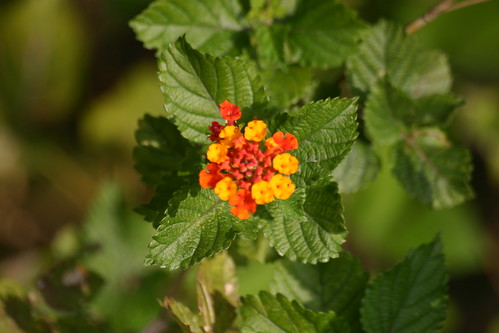On our morning walk I saw these bicolored flowers of Lantana camara. Their little orange and yellow bouquets reminded me somewhat of the Western Wallflowers back in New Mexico.

The clustered seed pods of this invasive (and poisonous) introduced shrub are blue.

Its flowers attracted a similarly-colored Julia Longwing (Dryas julia).

When I said that there are only two ways for a birder to find birds: “Either get out and chase them or let them come to you,” I was guilty of gross oversimplification. I am reminded of the old saw about the woman who prayed every day for 40 years that she would win the lottery, and God finally answered her prayer by saying “Buy a ticket!” No, the birds seldom come to you.
Many times I have birded for several hours and caught but single glances at one or more sought-after species. Some of my life birds were unexpected, one-time encounters. My first and only Great Cormorant just happened to be sitting alone on a bouy in Cape May as we boated by. If I had not been out in the back yard fishing one morning I would never have seen the first flock of Greater Flamingos reported in Broward County in several years. Sighting all of these birds may appear simply to have been blind luck, but it only happened because I was outside when the birds were somewhere near me at the time. Avid birders who often report rare sightings acquire their skills and amass huge trip and life lists not only by being where the birds are, but also being there when the birds are.
There is that important dimension of the amount of time one spends in the field. Some of the most treasured memories of my childhood were the Saturday mornings when my father took me “down the river” (which to us meant the Passaic River floodplain in Rutherford– just as New Jersey folks say “down the shore” when they mean the Atlantic Ocean beaches). We would follow rabbit tracks in the snow and catch garter snakes and red salamanders in that marvelous place, now entirely “reclaimed” as houses and condos. Later I would go there with my buddies and find such marvels as cuckoo nests and grasshoppers impaled on thorn bushes by Loggerhead Shrikes, flush woodcocks hidden in the leaf litter underfoot, and once, in a small sunlit clearing, witness the courtship dance of a pair of Rose-breased Grosbeaks. Just being there “down the woods” imparted such a great feeling of freedom from and yet, connection, to the world around me.
Sadly, as reported last October in the San Francisco Chronicle, kids are losing this attachment to the natural world:
“State and national parks, it seems, are good places for old folks to go, but the consensus among the younger set is that hiking boots aren’t cool. Besides, images of nature can be downloaded these days. “
This is so true. I have led youngsters on nature hikes with their teachers, who appeared not to even notice that some of their charges were wearing ear buds, listening to their Walkmans (see, I am as old as the trees– iPods had not yet been invented).
One day when I was serving as an interpreter at Rio Grande Nature Center, a box turtle wandered across the path in front of a small family group just as I was passing by. One child picked up the turtle, and I then gently suggested that it would be happier back in the grass. Once placed back on the ground it withdrew its head and legs, closed its plastron, and remained motionless. A smaller sibling, after staring at the immobile reptile for several seconds asked “Batteries?” Perhaps he thought they had run down!












